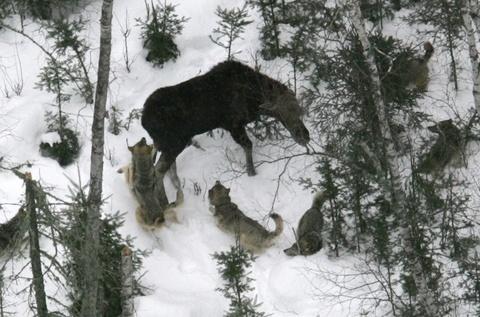I've long wanted to visit Isle Royale National Park. The mix of rock and forest surrounded by Lake Superior has intrigued me for many years, as has the park's resident wolf and moose populations.
Some think wolves reached the island in the 1940s during one of the winters when the lake waters surrounding Isle Royale froze solid and provided a bridge to the mainland. By 1958, wildlife biologists realized this provided the perfect setting for prey-predator studies, and Durward Allen launched the initial study of the park's wolves and moose.
Throughout 2008 park officials will be celebrating the 50th consecutive year of wolf-moose studies -- a mark of longevity no other prey-predator study has matched -- with a series of talks, programs, and commemorative books and posters.
“The anniversary is a fantastic opportunity to get kids excited about science and to inform the public about wolves, moose, conservation of natural resources and the conduct of scientific research, ” says Phyllis Green, Isle Royale's superintendent.
Watching the interplay of wolves and moose these days are Rolf Peterson and John Vucetich, population biologists at Michigan Tech’s School of Forest Resources and Environmental Science. They do aerial and ground observations in summer and winter, collect moose and wolf bones to analyze, and study vegetation, climate, air and water contaminants, and other environmental factors, according to a joint release from Michigan Tech and the National Park Service.
“Although wolves and moose are in the spotlight, this study has implications for understanding the broader components of an ecosystem,” says Peterson, who has headed the Isle Royale wolf-moose study since 1976.
The primary lesson learned from this long-running study is that wildlife systems are complex, unpredictable and dynamic by nature, and they are influenced by a large number of environmental factors, says Vucetich. “The data collected in the Isle Royale study provide a historical perspective that is very different from isolated snapshots of 5- or 10-year periods,” he explains. Collection of thousands of moose bones over decades, for example, enabled scientists to assess the levels of mercury and lead accumulation in bones prior to and after changes in clean air regulations.
How long this research will continue is hard to say, as climate change could bring it to a halt sooner than biologists would prefer. Moose are not comfortable under increasingly warmer temperatures, and could move north off the island if year-round temperatures at Isle Royale grow too warm.




Comments
You would be well rewarded to visit this little piece of heaven Kurt. During my teenage years, while spending much time skiing nearby on the Upper Peninsula, I made frequent side trips to the Apostle Islands and surrounding area, even mistakenly driving my car onto frozen Lake Superior at one point, but that's another story. I had my first encounters with black bears, moose, wolves, wolverines, and badgers in this area, discovering and developing my appreciation of true wildlife from visiting these critters on their home turf. It remains to this day on of the few purely natural environs in the lower 48, mostly due to the fact that winters are absolutely brutally cold and snowy, and it's a LONG drive in through sparsely populated woodlands in the summer with weather conditions that change literally but the mintue. Must have something to do with this small landmass isolated in the middle of a BIG, cold lake. But the rewards SO justify the effort, as is usually the case. You can readily traverse the Isle over the course of just a few days, allowing time to stop and smell the roses along the way. Bring your rain gear, cameras, notebook, binoculars, along with many pair of dry socks and have yourself a great time! But leave the swimsuits home. I saw one fellow jump in the Big Lake, at it's peak summer temperature akin to the Colorado between the dams....well, let's just say his hair was still standing on end 4 days later, and his goosebumps looked like boils. Okay, maybe 4 hours later.